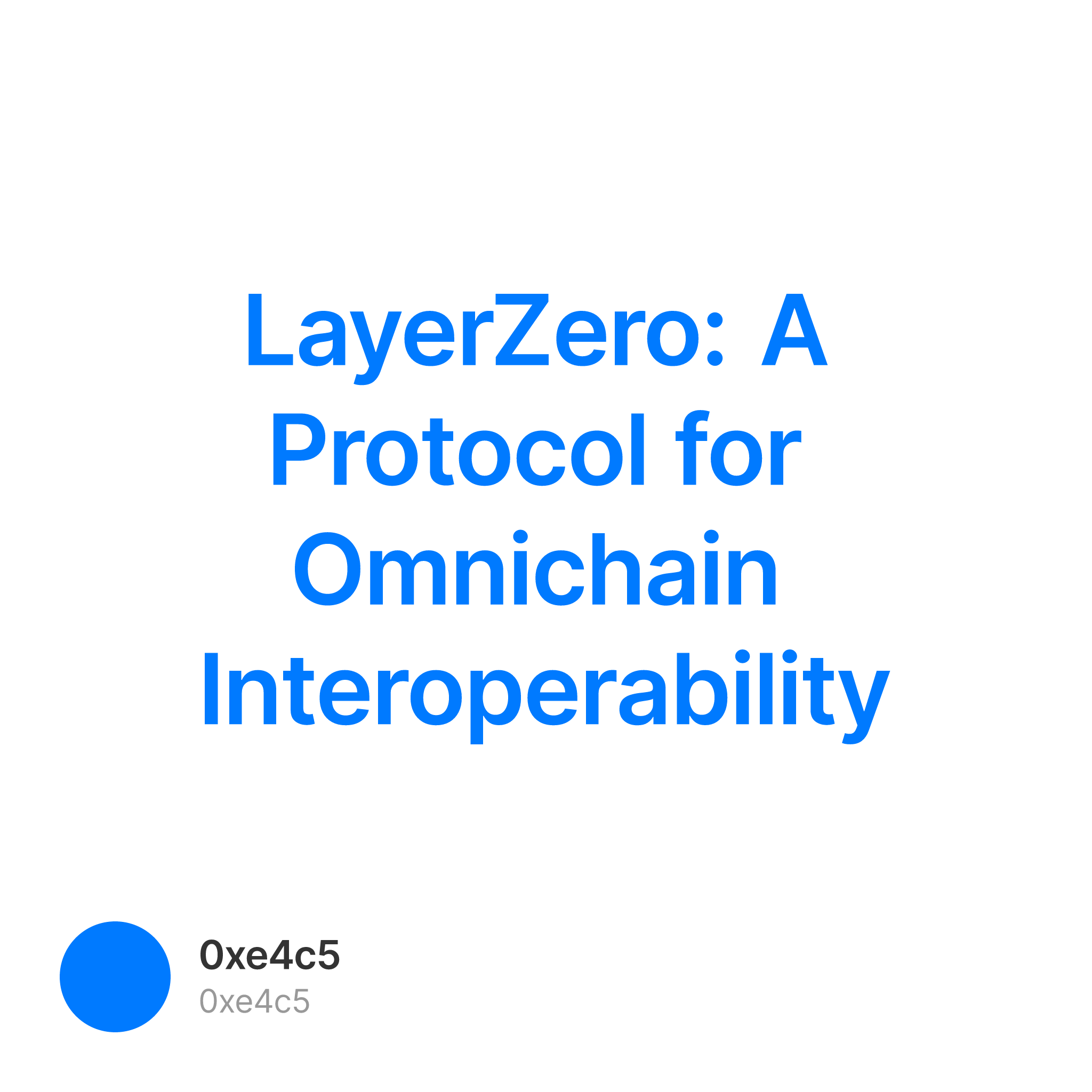LayerZero: A Protocol for Omnichain Interoperability
What is LayerZero?
LayerZero is a protocol that connects blockchains and allows developers to build seamless applications, tokens, and experiences across 50+ blockchains. LayerZero provides authentic and guaranteed message delivery with configurable trustlessness. It is a “blockchain of blockchains” that allows other blockchain networks to communicate directly and in a trustless manner.
LayerZero’s key feature is Ultra Light Nodes (ULNs). These smart contracts run on each blockchain and act as endpoints for cross-chain communication. ULNs verify the validity of transactions and messages from other chains using block headers and transaction proofs, ensuring security and efficiency.
LayerZero supports any blockchain that can run smart contracts, such as Ethereum, BNB Chain, Avalanche, Polygon, Arbitrum, Optimism, Fantom and other chains. LayerZero also supports non-EVM chains like Aptos. These so-called omnichain applications should become a key layer of a multi-chain future, where different blockchains interact simultaneously.
The protocol does not have a dedicated roadmap but plans to integrate with more blockchains and DeFi protocols in the future. There are plans to create its own governance token and DAO. LayerZero aims to create the optimal interoperability solution for blockchains with seamless and trustless cross-chain transactions.
Who Are the Founders of LayerZero?
LayerZero Labs, the company behind LayerZero protocol, was co-founded by Bryan Pellegrino, Ryan Zarick, and Caleb Banister in 2021. Bryan Pellegrino is the CEO of LayerZero Labs. He has a PhD in Computer Science from Carnegie Mellon University, where he focused on game theory and artificial intelligence. Ryan Zarick is the CTO of LayerZero Labs. He is a former software engineer at Google and a co-founder of Predictive AI, a machine learning startup that was acquired by Facebook in 2019. Caleb Banister is the Principal Engineer of LayerZero Labs. He is a former software engineer at Facebook and a co-founder of Predictive AI and has a BS in Computer Science from Carnegie Mellon University, where he also focused on game theory and artificial intelligence.
LayerZero Labs has also attracted some of the most prominent investors in the crypto space, such as a16z, Sequoia, Paypal Ventures, Polygon, Coinbase Ventures, Binance Labs, DeFiance Capital, Spartan Group, Sino Global Capital, Multicoin Capital and more. The company raised $135 million in a Series B round in March 2022 and another Series B of $120 million in April 2023.
What Makes LayerZero Unique?
LayerZero distinguishes itself from other interoperability solutions in several ways:
• Ultra Light Nodes (ULNs): LayerZero uses on-chain ULNs, which are smart contracts that run on each blockchain and act as endpoints for cross-chain communication. ULNs verify the validity of transactions and messages from other chains using block headers and transaction proofs, ensuring security and efficiency.
• Configurable Security Stack: LayerZero allows users and developers to choose their own level of security and trustlessness for cross-chain communication. Users can select from different types of ULNs, such as full, light, or zero, depending on their preferences and needs. Developers can also customize their own ULNs with different parameters and features, such as gas limits, timeouts, fees, and more.
• Permissionless Executors: LayerZero relies on a permissionless set of executors, which are nodes that relay messages between chains. Executors are incentivized by fees and reputation to perform their tasks honestly and efficiently. Executors can also stake tokens to increase their chances of being selected and rewarded.
• Omnichain Development: LayerZero enables omnichain development, which is the ability to build applications, tokens, and experiences that span across multiple blockchains. LayerZero provides unified semantics and standards for cross-chain communication, such as function calls, data exchange, governance votes, NFT transfers, and more. LayerZero also supports any type of cross-chain communication, such as synchronous, asynchronous, or hybrid.
How to Use LayerZero?
To use LayerZero, users and developers need to interact with the ULNs on each blockchain. Users can send and receive messages across chains by calling the ULN functions, such as _lzSend, _lzReceive, and _lzVerify. Developers can build omnichain applications by deploying smart contracts that inherit from the LayerZero core contracts, such as OApp, OFT, and ONFT. Developers can also use the LayerZero SDK and API to simplify the development process and access the LayerZero features.
LayerZero also provides a user-friendly interface called LayerZero Scan, which allows users and developers to monitor and track the cross-chain messages and transactions. LayerZero Scan also provides analytics and statistics on the LayerZero network, such as the number of messages, supported blockchains, value transferred, and more.
Conclusion
LayerZero is a protocol that connects blockchains and allows developers to build seamless applications, tokens, and experiences across 50+ blockchains. LayerZero provides authentic and guaranteed message delivery with configurable trustlessness. It is a “blockchain of blockchains” that allows other blockchain networks to communicate directly and in a trustless manner.
LayerZero uses on-chain ULNs, which are smart contracts that run on each blockchain and act as endpoints for cross-chain communication. ULNs verify the validity of transactions and messages from other chains using block headers and transaction proofs, ensuring security and efficiency. LayerZero also relies on a permissionless set of executors, which are nodes that relay messages between chains.
LayerZero enables omnichain development, which is the ability to build applications, tokens, and experiences that span across multiple blockchains. LayerZero provides unified semantics and standards for cross-chain communication, such as function calls, data exchange, governance votes, NFT transfers, and more. LayerZero also supports any type of cross-chain communication, such as synchronous, asynchronous, or hybrid.
To use LayerZero, users and developers need to interact with the ULNs on each blockchain. Users can send and receive messages across chains by calling the ULN functions. Developers can build omnichain applications by deploying smart contracts that inherit from the LayerZero core contracts. Developers can also use the LayerZero SDK and API to simplify the development process and access the LayerZero features.
